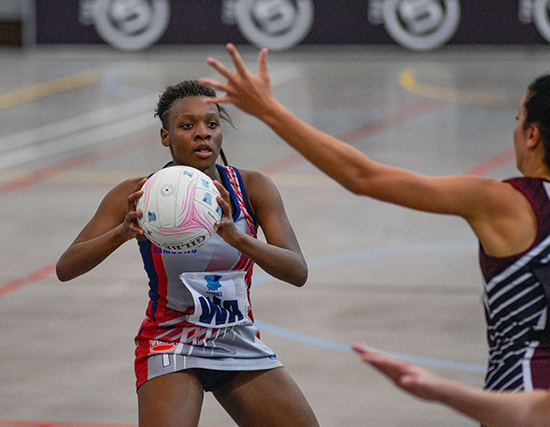Latest News Archive
Please select Category, Year, and then Month to display items
27 September 2018
Photo Varsity Sports
 Newly capped Protea Khanyisa Chawane will return for the Kovsies on Monday when they face the Maties in the semi-final of Varsity Netball in the Callie Human centre.
Newly capped Protea Khanyisa Chawane will return for the Kovsies on Monday when they face the Maties in the semi-final of Varsity Netball in the Callie Human centre.
A first ever Varsity Netball final in the Callie Human centre lie in what should the Kovsies cross the line this Monday in the semi-final against the Maties in Bloemfontein at 19:00.
Having ended first on the log, the Kovsies will enjoy home court advantage should they progress to the final on 8 October.
The Kovsies won their group fixture against the Maties last month in Stellenbosch by 59-56. It will be the first time the two teams clash in a knock-out match in the competition and also a first visit to the Callie Human centre for the Maties since 2013.
The Kovsies won six out of their seven group matches with their only loss against the Madibaz by a single goal.
They will be strengthened by the return of Khanyisa Chawane (centre) who missed a couple of matches whilst being in Australasia where she made her Protea debut. Meagan Roux, who can either play wing attack or goal attack, is also back. She travelled with the Proteas as a replacement.
They will however be without Tanya Mostert who will be on honeymoon. Her wedding is on Saturday. Remarkable it will only be the second time since her debut in the Kovsies’ very first match in the inaugural competition in 2013 that Mostert will miss a Varsity Netball match.
“The players really yearn to lift that trophy. It’s been some time since we last played in the final (in 2014). My message to them will be to give it their all on Monday,” Mostert said.
According to her the team is currently one that gels very nicely.
“Everyone fully understands their role in the team. We realized where our strengths lie and play according to it. Adding to that we play for one another.”
Photo manipulation in journalism: evil, crutch or lifebuoy?
2017-09-04

Albe Grobbelaar, veteran journalist and lecturer in the
Department of Communication Science at the UFS.
Photo: Rulanzen Martin
Since the 1800s the manipulation of photographs has been common practice, and who can forget the OJ Simpson Time magazine cover in 1994? Albe Grobbelaar, lecturer in the Department of Communication Science at the University of the Free State (UFS), asked in a special lecture on 18 August 2017 whether “Photo manipulation in Journalism” was an evil habit, a crutch or a lifebuoy.
“As a journalist I have always been interested in photography. And the principle of photo manipulation or tampering with photos, as we call it, is something that has interested me ever since,” Grobbelaar said. Photo manipulation is an area that has garnered many academic interest and is not a new trend but a practice that started in the 1830s when photos came into popular use. “It is not always done with ulterior motives, artists played with photographs to get unique effects.” Photo manipulation is not only to create fake news, but is sometimes used to convey novelty and create shock to news readers.
Different viewpoints for different circumstances
He talked about the spectrum of viewpoints on photo manipulation. Some conservative journalism schools say photos should never be retouched while other feel it is fine to tamper with pictures. “What I tried to convey in the lecture was that one should consider different circumstances differently,” Grobbelaar said. As a journalist he believes that news photos should never be manipulated.
He mentioned the example of the mugshot of OJ Simpson that the Los Angeles Police Department released to the media. “Newsweek and Time both used the photo on their front pages, but Time deliberately darkened the picture so that OJ, a black man, would appear more sinister,” Grobbelaar said. It is, however, common practice in the fashion industry to retouch images that are used in fashion magazines.
Use own judgment to validate photos
In the age of social media it has become easy to manipulate photos and which has been labelled fake news. “I would advise people to use their own judgment when validating the authenticity of photos,” Grobbelaar said. It is important to verify whether they are from a reliable news outlet.